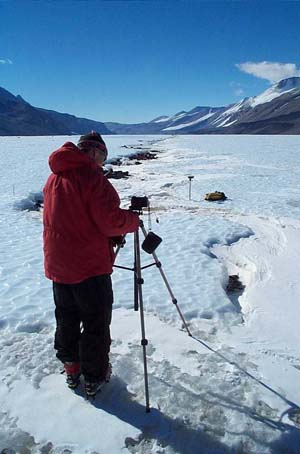
From Robin Johnston
Hi all -
We are down to only three field days left and one pack-up/clean-up day before we head back to McMurdo. We'll spend a few days there returning equipment and finishing up some research before we leave the ice for Christchurch. Being in this phenomenal place has truly been the experience of a lifetime. Not only is it a glaciologists heaven - you can't go wrong here as a geologist either. The rock/stratigraphy/structure is incredible as well. We have spent a lot of time in the ablation (ice) zone of the glaciers, so it was a treat yesterday when we got to fly up over Taylor Valley and the mountains into some of the neighboring valleys. The amount of snow up there is unbelievable and spectacular.
Thomas setting up tripod in channel
(Click on image for larger version)
|
Cross Section of Channels |
Pool at bottom of channel |
We finished up gathering data on Taylor Glacier the other day and what a great experience that turned out to be. My project concerns the development of channels on lower Taylor Glacier. These channels play an important role in producing melt water that feeds Lake Bonnie, which is the proglacial lake fed by Taylor Glacier and other minor streams in the area. The amount and mode of melt water feeding the lake from Taylor Glacier will have an effect on the microbial ecology of the system. We surveyed in a series of cross sections down glacier along the channel. I will use the cross sections in conjunction with the ice velocity in an attempt to determine the rate of channel formation and any spatial changes in this rate as the channel progresses down glacier. Albedo measurements (outgoing shortwave radiation divided by incoming shortwave radiation) were also taken at the survey points and I will use this data to look at any possible correlation between albedo, ablation, and channel formation. In surveying in the cross sections and gathering albedo data, we often had to belay because the ice was very steep. As you can see from the pictures, these walls can be vertical. I'm sending these three photos so you get some idea of the amount of development in these channels. The fourth photo is a view of part of camp and Lake Hoare from Canada Glacier. The great mountain in the background is 1812 in the Asgard Range. A beauty, yes? The last one is of us working on the met station in Wright Valley.
|
Part of camp and Lake Hoare from Canada Glacier |
Met station in Wright Valley |
Yesterday we finished up all of Thomas's field work. He was pretty excited about that after all these weeks. We traveled around to the various meteorological stations in Wright Valley (Lake Vanda) and Victoria Valley (Lake Vida). There were five of us in an ASTAR helicopter. The view is much better in these smaller helicopters than in the larger ones we often flew in to get to Taylor Glacier. Sunday we are going to the Allan Hills and the Blue Ice area of the East Antarctic Ice Sheet as a pleasure trip. Hopefully this trip will be on an ASTAR.
There are excellent pilots maneuvering these rigs. They land as close to us on the ice as they can so we don't have to carry our equipment too far. Well, the other day I'm laying on my gear with my head down (as you do when the helicopters land) and I turned my head to one side and got a look at Andrew's face and see him mouthing a few words I won't repeat here. Obviously, they were landing too close for Andrew's comfort. How close? Well, I looked straight up at that point and could see the BLADES rotating ABOVE my HEAD - and a good amount of the blades, not just the tips. I could reach out and touch that helicopter when it was safe to look about. What a thrill! Thomas also got some good pictures of Blood Falls erupting as the helicopter hovered near the glacier.
Andrew, Martyn, and I are headed up to Canada Glacier today and Thomas is going to stay in camp and work up some data. Martyn wants to gather some more water samples and Andrew has rigged up a contraption to measure the hydrologic response time of the glacier (can you say slug test, Michelle?). Be seeing you all soon.
Happy travels,
Robin